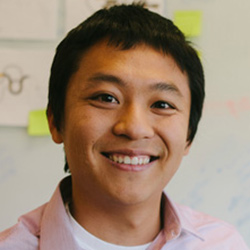Training Ecosystem Taps the Power of Community
Haoqi Zhang's Agile Research Studios is churning out the next generation of research superstars.

“This kind of success is almost unheard of,” says Zhang, the Allen K. and Johnnie Cordell Breed Junior Professor of Design and assistant professor of computer science. “But this outcome is not our goal in and of itself. It’s a natural result of the process.”
That process is Agile Research Studios, a community-based research training system that Zhang developed over several years and, in 2015, implemented into the Design, Technology, and Research program that he co-leads with Professor Eleanor O’Rourke. Agile Research Studios is a computational ecosystem in which the research process, social structures, and tools work together to support community members learning how to conduct self-directed research.
The inspiration behind Agile Research Studios is simple: faculty members are overtaxed. To develop into dynamic thinkers and problem solvers, students need the quality mentoring and sustained training that faculty members are often unable to provide one-on-one. Zhang removed the one-on-one aspect of mentoring and replaced it with a robust network of faculty, student peers, and graduate students.
“Students help faculty with research, but they’re often not being trained in the process,” he says. “They typically just follow a plan that’s handed to them. We want to create independent researchers who drive research and approach complex problems.”
How It Works
Agile Research Studios makes research goals more attainable by breaking down long-term projects into manageable two-week-long design sprints. During these sprints, students plan and complete specific, smaller goals that deliver value to the project. The process encourages students to dive into their research by building simple prototypes, running tests, making measurements, and reflecting. At first, their experiments might be low fidelity, but prototypes and tests increase in sophistication as the students learn and develop their skills.
“The point is that students are getting involved with authentic research sooner,” Zhang says. “They learn by doing many iterations—even if those experiments are imperfect.”
“It makes use of expertise in the most effective way possible. Pairs are matched to help each other, so reciprocity is built into the system. Over time, this reciprocity builds a more supportive community.”
In all projects, researchers will eventually hit an impasse. This is where the community comes into play. Agile Research Studios’ social structure facilitates help-seeking and collaboration to promote learning and progress. In virtual and in-person meetings, mentors and peers help students think through problems and strategize ways to overcome them.
Finding Help Along The Way
One way students find help is through Pair Research, an online platform that simplifies the process of asking for and receiving help. Students can visit the online platform, describe the task they need help with, and estimate how much time is needed to accomplish the task. For example, the student might need someone to proofread a paper, test computer code, or provide motivation to stop procrastination.
Other users then respond to the request, rating their ability to help with the task on a scale of one to five. A matching algorithm then recommends the most optimal pairings for collaboration, informal learning, and productivity.
“It makes use of expertise in the most effective way possible,” says Zhang, who developed Pair Research with Professor Elizabeth Gerber. “Pairs are matched to help each other, so reciprocity is built into the system. Over time, this reciprocity builds a more supportive community.”
Agile Research Studios’ results speak for themselves. Most recently, junior Sarah Lim took first place at the Association for Computing Machinery Computer-Human Interaction Student Research Competition in spring 2017 for her system that inspects web pages to find specific snippets of source code. This allows users to search for relevant code for their own pages without sifting through volumes of complex HTML hierarchies.
While Agile Research Studios enables students to blossom into independent thinkers and researchers, it also helps grow their confidence. Throughout the course of the program, students become more autonomous and self-directed. Zhang is continually amazed by the personal growth he witnesses in students from the start to the end of the program.
“I’m proud of my students’ accomplishments but most proud of their continued growth and depth of understanding,” Zhang says. “By leveraging the whole community, they learn how to make arguments, think critically, solve problems, and write papers. That’s what the program is designed to do.”
